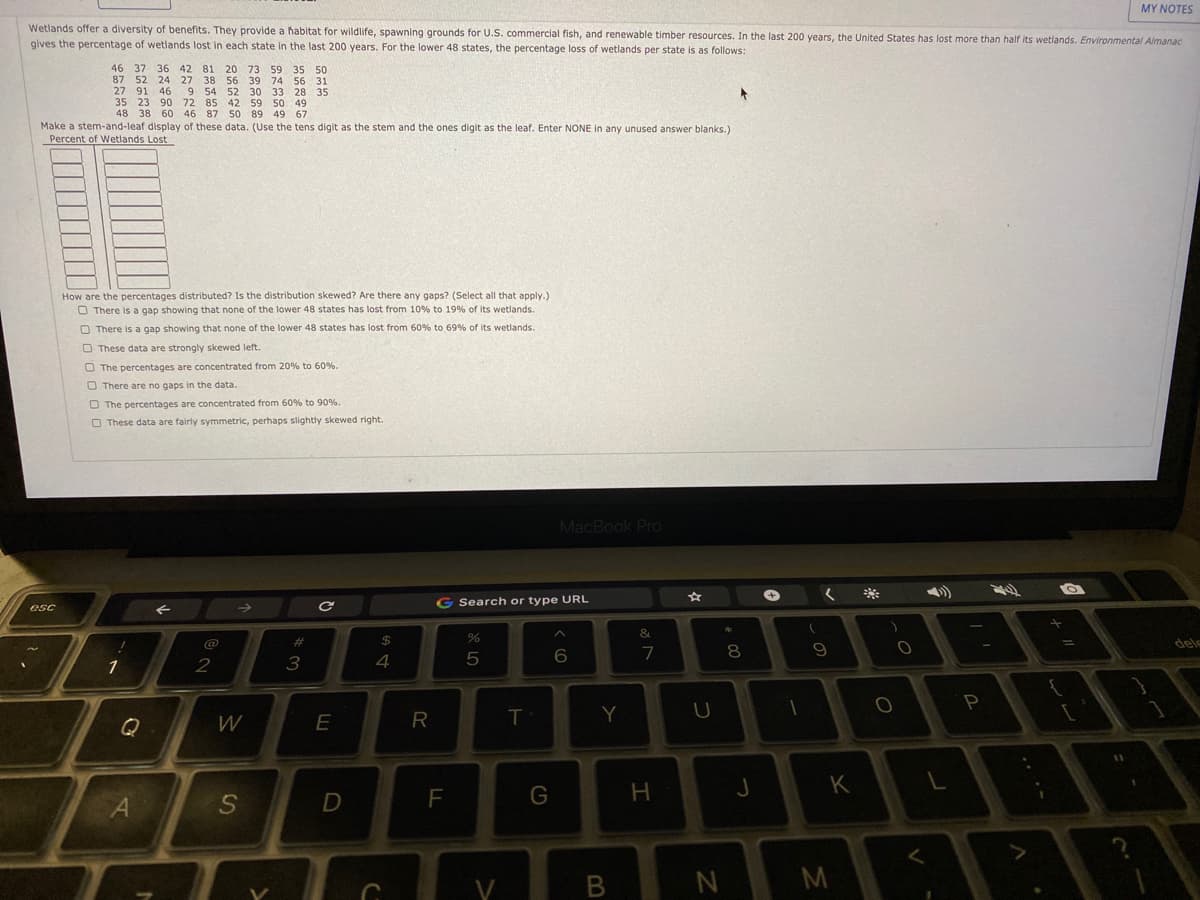59 50 49 48 38 60 46 87 50 89 49 67 Make a stem-and-leaf display of these data. (Use the tens digit as the stem and the ones digit as the leaf. Enter NONE in any unused answer blanks.) Percent of Wetlands Lost How are the percentages distributed? Is the distribution skewed? Are there any gaps? (Select all that apply.) O There is a gap showing that none of the lower 48 states has lost from 10% to 19% of its wetlands. O There is a gap showing that none of the lower 48 states has lost from 60% to 69% of its wetlands. O These data are strongly skewed left. O The percentages are concentrated from 20% to 60%. O There are no gaps in the data. O The percentages are concentrated from 60% to 90%. O These data are fairly symmetric, perhaps slightly skewed right.
59 50 49 48 38 60 46 87 50 89 49 67 Make a stem-and-leaf display of these data. (Use the tens digit as the stem and the ones digit as the leaf. Enter NONE in any unused answer blanks.) Percent of Wetlands Lost How are the percentages distributed? Is the distribution skewed? Are there any gaps? (Select all that apply.) O There is a gap showing that none of the lower 48 states has lost from 10% to 19% of its wetlands. O There is a gap showing that none of the lower 48 states has lost from 60% to 69% of its wetlands. O These data are strongly skewed left. O The percentages are concentrated from 20% to 60%. O There are no gaps in the data. O The percentages are concentrated from 60% to 90%. O These data are fairly symmetric, perhaps slightly skewed right.
Linear Algebra: A Modern Introduction
4th Edition
ISBN:9781285463247
Author:David Poole
Publisher:David Poole
Chapter4: Eigenvalues And Eigenvectors
Section4.6: Applications And The Perron-frobenius Theorem
Problem 22EQ
Related questions
Topic Video
Question
100%
Can anybody help me with this?

Transcribed Image Text:MY NOTES
Wetlands offer a diversity
gives the percentage of wetlands lost in each state in the last 200 years. For the lower 48 states, the percentage loss of wetlands per state is as follows:
benefits. They provide a habitat for wildlife, spawning grounds for U.S. commercial fish, and renewable timber resources. In the last 200 years, the United States has lost more than half its wetlands. Environmental Almanac
46 37
36 42
81 20 73 59 35 50
27 38 56 39 74 56 31
87
52
24
9 54 52
27 91
35 23
48 38 60 46
46
30 33 28 35
42
59 50 49
90
72
85
87 50 89 49 67
Make a stem-and-leaf display of these data. (Use the tens digit as the stem and the ones digit as the leaf. Enter NONE in any unused answer blanks.)
Percent of Wetlands Lost
How are the percentages distributed? Is the distribution skewed? Are there any gaps? (Select all that apply.)
O There is a gap showing that none of the lower 48 states has lost from 10% to 19% of its wetlands.
O There is a gap showing that none of the lower 48 states has lost from 60% to 69% of its wetlands.
O These data are strongly skewed left
O The percentages are concentrated from 20% to 60%.
O There are no gaps in the data.
O The percentages are concentrated from 60% to 90%.
O These data are fairly symmetric, perhaps slightly skewed right.
MacBook Pro
G Search or type URL
esc
&
%23
2$
dele
6.
7
2
3
P
Q
W
E
R
Y
K
F
V
* 00
Expert Solution
This question has been solved!
Explore an expertly crafted, step-by-step solution for a thorough understanding of key concepts.
This is a popular solution!
Trending now
This is a popular solution!
Step by step
Solved in 2 steps

Knowledge Booster
Learn more about
Need a deep-dive on the concept behind this application? Look no further. Learn more about this topic, statistics and related others by exploring similar questions and additional content below.Recommended textbooks for you

Linear Algebra: A Modern Introduction
Algebra
ISBN:
9781285463247
Author:
David Poole
Publisher:
Cengage Learning

Mathematics For Machine Technology
Advanced Math
ISBN:
9781337798310
Author:
Peterson, John.
Publisher:
Cengage Learning,

Holt Mcdougal Larson Pre-algebra: Student Edition…
Algebra
ISBN:
9780547587776
Author:
HOLT MCDOUGAL
Publisher:
HOLT MCDOUGAL

Linear Algebra: A Modern Introduction
Algebra
ISBN:
9781285463247
Author:
David Poole
Publisher:
Cengage Learning

Mathematics For Machine Technology
Advanced Math
ISBN:
9781337798310
Author:
Peterson, John.
Publisher:
Cengage Learning,

Holt Mcdougal Larson Pre-algebra: Student Edition…
Algebra
ISBN:
9780547587776
Author:
HOLT MCDOUGAL
Publisher:
HOLT MCDOUGAL



Glencoe Algebra 1, Student Edition, 9780079039897…
Algebra
ISBN:
9780079039897
Author:
Carter
Publisher:
McGraw Hill